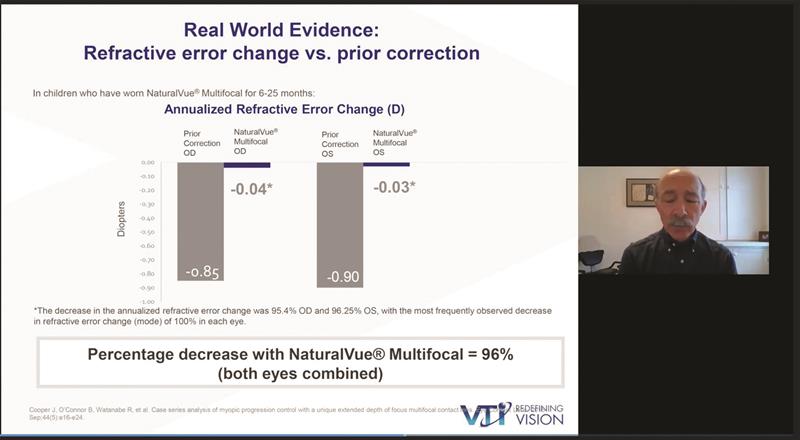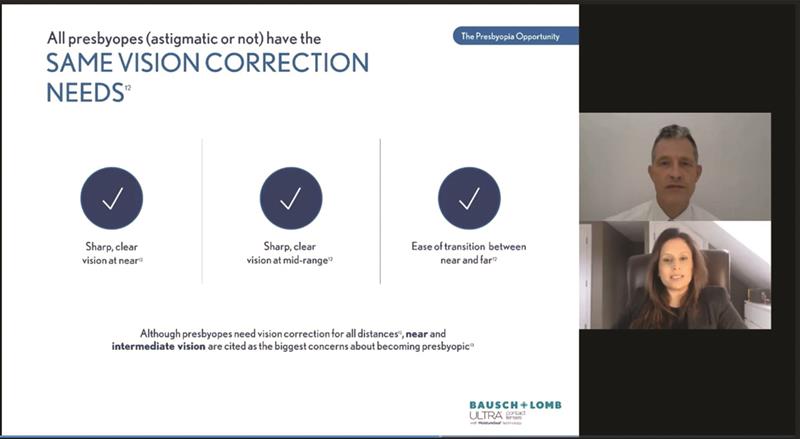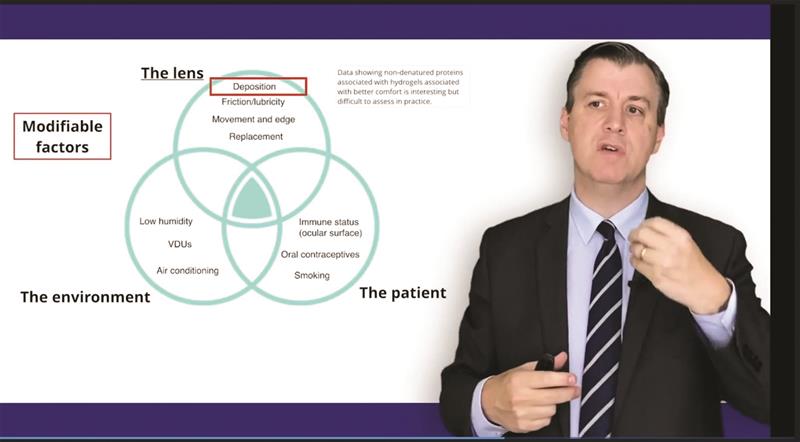
Three new product launches, a host of research findings and plenty of forthright opinions were on offer across the five evenings of Contact Lens Week, held on February 8-12.
Lockdown limitations have led to the cancellation of countless conferences, seminars and meetings, so to let a little light onto this increasingly dark scene, Optician organised a week of webinars organised around five fundamental themes facing the contact lens business.
The five topics – myopia control, presbyopia, contact lens comfort, torics and extended depth of focus – were each discussed in a two-part approach on their featured webinar. The first half of the webinar saw an Optician-invited speaker present on the topic in hand and then be interviewed and take questions posed by the online audience. The line-up included no fewer than three former or current BCLA presidents and world-renowned presenters including Professor Lyndon Jones, professor at the School of Optometry and Vision Science and director of the Centre for Ocular Research & Education (Core) at the University of Waterloo, Canada.
For the second half of each seminar a similar theme was followed but featured a speaker provided by the sponsoring company. This allowed real life situations to be discussed and enabled specific product launches to be placed front and centre.
Myopia management
Monday took myopia management as its theme and featured the current president of the BCLA, Indie Grewal. An on-the-night audience of 800 heard Grewal urge practitioners get more involved in pro-actively monitoring their young patients for signs of myopia so they could manage it as early as possible. He outlined the various contact lens methods currently available to manage myopia and shared his own spreadsheet as a download. Grewal has used this spreadsheet in his own practice to monitor potential patients. He went on to give other pointers and sources of reference for those wanting to get involved.
Audience questions showed a keen interest in just how young patients could start treatment and when might be too late. Wearing regimes and potential NHS funding were also discussed.
The second half of Monday’s webinar featured an overview of a study by the session’s sponsor Visioning Technologies Inc. Executive director of professional services, Dr Doug Benoit, outlined the success of the NaturalVue Multifocal lens in myopia management by sharing the results of a retrospective study. The study showed a 98% decrease in refractive error change among those wearing the lens with 81% showing no refractive error increase or a decrease in refractive error.
 Dr Doug Benoit, outlined the success of the NaturalVue Multifocal lens in myopia management
Dr Doug Benoit, outlined the success of the NaturalVue Multifocal lens in myopia management
Presbyopia
Tuesday turned the focus on presbyopia with former BCLA president Keith Tempany leading the discussion. He outlined presbyopia and the multifocal designs to combat it. An emphasis was also placed on the emotional side of
presbyopia and strategies to prepare patients for multifocal wear.
Sponsoring the second half of the discussion, Bausch and Lomb’s professional affairs manager for the UK, Ireland and the Nordics, Dimple Zala continued the educational theme. She focused on astigmatic presbyopes, which she described as an often overlooked group of wearers. She introduced Bausch and Lomb’s Ultra Multifocal for Astigmatism contact lens and said the toolkit of lenses had now been opened to serve astigmats as they progressed into presbyopia with an easy to fit soft lens. Tempany agreed that the lens would open up the market and meant ECPs would not have to worry about the patient’s prescription before offering soft lenses. A discussion also took place on why ECPs are not routinely offering multifocal lenses. Chair time, cost and lack of confidence were all mentioned with Tempany concluding that many ECPs were too young themselves to appreciate the many benefits of multifocals. The online audience was keen to learn more about the Ultra Multifocal for Astigmatism availability and lens parameters.
 Chris Bennett and Dimple Zala focused on the often overlooked astigmatic presbyopes
Chris Bennett and Dimple Zala focused on the often overlooked astigmatic presbyopes
Contact lens comfort
The midpoint of the week offered an educational treat courtesy of Professor Lyndon Jones. In an informative and entertaining presentation he discussed the ‘category killer’ of drop out and discussed why it still remained a problem despite the advances made in contact lens technology. Materials, tear film interaction and environmental factors were discussed with questions coming thick and fast on the role of allergy, the potential for rewetting drops and the emergence of new materials such as Alcon’s water gradient technologies. He said materials technology continued to improve while ECPs and patients could also do more to improve comfort and reduce drop out.
Sponsoring the session on contact lens comfort was Alcon and it invited Professor Philip Morgan of the Eurolens Research Division of Pharmacy and Optometry at the University of Manchester to continue the discussion. His presentation suggested how discomfort and drop out could be ameliorated and he raised the Dunning-Kruger effect. It suggests people tend to overestimate their own abilities and Morgan said this could be at play in ECPs’ assessment of their clinical and communication skills before suggesting practical ways in which early drop outs might be prevented.
 Professor Philip Morgan suggested how discomfort and drop out could be ameliorated
Professor Philip Morgan suggested how discomfort and drop out could be ameliorated
The second new lens launch featured in Contact Lens Week was Alcon’s Precision 1. Alcon invited Dr Kathy Dumbleton, associate professor at the University of Berkeley, California, to describe the lens that she said offered the comfort, vision and ease of handling needed to minimise drop outs. She went on to describe the lens’ Smartsurface technology which creates a water rich surface interaction to enable a stable tear film.
On hand was Alcon head of professional affairs, Jonathon Bench, who took questions on the lens and described where Precision 1 sat in the portfolio of Alcon products. Communi-cation and wear times were discussed along with practical practitioner actions to reduce drop out.
Torics
Torics took centre stage for Thursday’s discussion with professional services consultant Phil Thompson, offering his 37 years of experience to shed some light on contact lenses for astigmatism. He said that despite close to half of patients having 0.75 dioptres of astigmatism and 87% having astigmatism in at least one eye around just a quarter of fits were torics. Modern designs mean over 90% of patients can be fitted with a mainstream soft design, Thompson also went on to discuss the role rigid gas permeable (RGP) and hybrid lenses can play in offering to those outside the range of soft lenses.
Johnson and Johnson sponsored the second half of the webinar with professional affairs manager, Dr Rachel Hiscox, discussing astigmatism and Acuvue for Astigmatism lenses. She kicked off with two polls asking delegates what proportion of wearers had astigmatism of 0.75 DC or greater and how many of their fits where for toric lenses. The results showed that while 47% had astigmatic patients just two out of 10 fits were with torics.
She provided the latest research on the prevalence of astigmatism and the affects on the quality of vision. She went on to discuss the role blinking plays in stability before discussing Johnson & Johnson’s Eyelid Stabilised Design. This, she said, produces more stability than ballast designs and does not induce any prism as was the case with some lenses. She said it was important that ECPs understood the different designs to give their patients options to achieve a successful fit. To emphasise the comprehensive nature of the Acuvue range she said 96% of astigmats could be covered using the range which offered lenses in 4,950 combinations of parameters.
Extended Depth of Focus
The final topic for Contact Lens Week was the emerging area of extended depth of focus (EDOF). Providing an introduction to the technology was Nick Atkins of Positive Impact. He explained the basic principles behind EDOF lenses, the designs currently on the market and which patients can benefit from them. He said that while the two main uses for EDOF lenses are for presbyopia and in myopia management there are also opportunities for the alleviation of visual stress. Delegates were very interested in the technology and quizzed Atkins on its ability to correct astigmatism and the visual play-off for peripheral vision. That discussion was continued following a presentation by Synergeyes, the sponsor for the session on EDOF. Its presenter, Dr Louise Sclafani, vice president of professional affairs, provided details of the third new lens of the week. She introduced the SynergEyes iD and described how the iD combines a hybrid lens construction with EDOF optics. This, she said, combines the optical benefits of an RGP centre with the comfort benefits of a silicone hydrogel skirt and EDOF technology. SynergEyes uses the Brien Holden Vision Institute EDOF design, which she said means the lens can be used for presbyopia or myopia management.
 Dr Louise Sclafani introduced the new Synergeyes iD lens
Dr Louise Sclafani introduced the new Synergeyes iD lens
In the resulting question and answer session Dr Sclafani emphasised the ease of fitting and the empirical approach to lens ordering from practice. She said she was very excited about the potential of EDOF. While the technologies employed may seem very specialist she concluded: ‘Aren’t all our patients special?’
